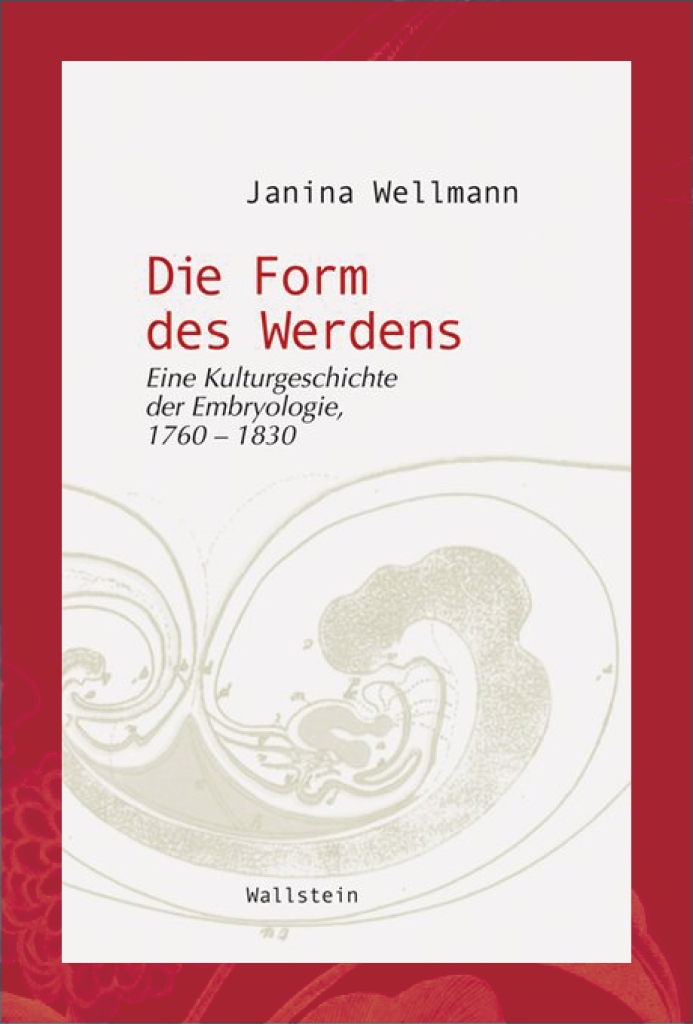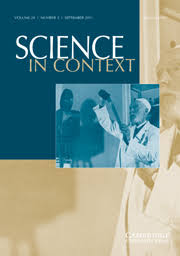Books

New York: Zone Books, 2024.

The Form of Becoming. Embryology and the Epistemology of Rhythm, 1760-1830
New York: Zone Books, 2017 (revised English translation of Die Form des Werdens).
Reviews: History and Philosophy of the Life Sciences 43 (2021), 41 [link]; Goethe Yearbook 26 (2019), 341-343 [link]; The Year’s Work in Critical and Cultural Theory 97 (2019) [link]; Radical Philosophy 2.04 (Spring 2019) [link]; Journal of the History of Biology (July 2019) [link]; British Society for Literature and Science [link]; BOMB Magazine [link].

Die Form des Werdens. Eine Kulturgeschichte der Embryologie, 1760-1830
Göttingen: Wallstein, 2010.
Reviews: Frankfurter Allgemeine Zeitung, November 25, 2010; literaturkritik.de, January 2011; British Journal for the History of Science 44 (2011), 601-603; Revue de l´Institut Français d´Histoire en Allemagne 3 (2011), 442-444; Isis 103/1 (2012), 205-206; Berichte zur Wissenschaftsgeschichte 35 (2012), 166-168; NTM 20/3 (2012), 241-243; Bildwelten des Wissens. Kunsthistorisches Jahrbuch für Bildkritik 10/2 (2014), 112-115.
Edited Volumes

Co-edited with Arianna Borrelli, NTM 27/4 (2019).

Computer Simulation in the Life Sciences
History and Philosophy of the Life Sciences 40/1 (2018).

Cinematography, Seriality, and the Sciences
Science in Context 24/3 (2011).
Articles and Book Chapters
Forthcoming
Life Sciences, Contemporary. In James M. Mattingly (ed.), The SAGE Encyclopedia of Theory in Science, Technology, Engineering, and Mathematics. Washington: Sage Publishing.
Metamorphosis in Images. Insect Transformation from the End of the Seventeenth to the Beginning of the Nineteenth Century. In Gemma Anderson, John Dupré (eds.), Drawing Processes of Life. Bristol, Chicago: Intellect Press.
2021
History of Embryology: Visualizations through Series and Animation. In David McCallum (ed.), The Palgrave Handbook of the History of Human Sciences. Singapore: Springer.
2019
Computer Simulations Then and Now: An Introduction and Historical Reassessment. NTM 27/4, 407-417 (together with Arianna Borelli).
Seduced by form or flow? Etienne-Jules Marey’s experiments on air flow dynamics. Wind Tunnel Bulletin, Zürcher Hochschule der Künste, N° 9 (June 2019): Das Experiment im Zeitalter seiner technischen Reproduzierbarkeit, 278-279.
Natur als Ereignis in den modernen Lebenswissenschaften. In Robert Felfe, Maurice Sass (eds.), Naturalismen. Kunst, Ästhetik, Wissenschaft. Berlin, Boston: De Gruyter, 205-213.
2018
Model and Movement. Studying Cell Movement in Early Morphogenesis, 1900 to the Present. History and Philosophy of the Life Sciences 40:59.
Gluing Life Together. Computer Simulation in the Life Sciences: An Introduction. History and Philosophy of the Life Sciences 40:70.
Bewegung an der Wand. Zur Aufführung von Organismen mit dem Sonnenmikroskop. Bildwelten des Wissens. Kunsthistorisches Jahrbuch für Bildkritik 14, 10-20. Reprint: In Nicola Gess, Agnes Hoffmann, Annette Kappeler (eds.), Belebungskünste. Praktiken lebendiger Darstellung in Literatur, Kunst und Wissenschaft um 1800. Paderborn: Fink 2019, 227-243.
2017
Listening to the Body Moving. Auscultation, Sound and Music around 1800. Journal of Sonic Studies 13.
Animating Embryos. The In Toto Representation of Life. The British Journal for the History of Science 50/3, 521-535.
Plastilin und Kreisel, Pinsel und Projektor. Julius Ries und die Materialität der seriellen Anschauung. In Gerhard Scholtz (Ed.), Serie und Serialität. Konzepte und Analysen in Gestaltung und Wissenschaft. Berlin: Reimer, 77-93.
2016
Paul Klee: Ich-Du-Erde-Welt. In Nikola Doll, Horst Bredekamp, Wolfgang Schäffner (Eds.), +ultra. Gestaltung schafft Wissen. Leipzig: E.A. Seemann, 138.
Karl Ernst von Baers Ontogenetische Reihe. In Nikola Doll, Horst Bredekamp, Wolfgang Schäffner (Eds.), +ultra. Gestaltung schafft Wissen. Leipzig: E.A. Seemann, 154.
2015
Folding into Being. Early Embryology and the Epistemology of Rhythm. History and Philosophy of the Life Sciences 37/1, 17-33.
2013
“Mit eben so viel Kunst als Wahrheit.” Die Entwicklung der Schmeißfliege im Bild bei Johann David Moritz Herold. Bildwelten des Wissens. Kunsthistorisches Jahrbuch für Bildkritik 9.2, 61-66.
Eine “höhere Form der Erkenntnis:” Körper, Rhythmus und Emotion um 1800. In Claudia Jarzebowski, Anne Kwaschik (eds.), Performing Emotions. Interdisziplinäre Perspektiven auf das Verhältnis von Politik und Emotionen in der Frühen Neuzeit und in der Moderne. Göttingen: Vandenhoeck & Ruprecht unipress, 187-213.
2011
Science and Cinema: An Introduction. Science in Context 24/3, 311-328.
Periplaneta americana (L.). Eine Naturgeschichte für das 21. Jahrhundert. Hommage à / Zu Ehren von / In Honor of Hans-Jörg Rheinberger. Berlin: Max-Planck-Institut für Wissenschaftsgeschichte, 120-132.
2008
Die Metamorphose der Bilder. Die Verwandlung der Insekten und ihre Darstellung vom Ende des 17. bis zum Anfang des 19. Jahrhunderts. NTM International Journal of History and Ethics of Natural Sciences, Technology and Medicine 2, 183-211.
Keine Ikone der Entwicklung. Die Icones embryonum humanorum von Samuel Thomas Soemmerring. In Ulrich Johannes Schneider (ed.), Kulturen des Wissens im 18. Jahrhundert. Berlin, New York: De Gruyter, 585-594.
Hand und Leib, Arbeiten und Üben. Instruktionsgraphiken der Bewegung im 17. und 18. Jahrhundert. In Rebekka von Mallinckrodt (ed.), Bewegtes Leben – Körpertechniken in der Frühen Neuzeit. Wolfenbüttel: Herzog-August-Bibliothek, 15-38.
Hand und Leib, Arbeiten und Üben – Katalog. In Rebekka von Mallinckrodt (ed.), Bewegtes Leben – Körpertechniken in der Frühen Neuzeit. Wolfenbüttel: Herzog-August-Bibliothek, 249-259.
2007
Rhythmus. Eine neue Figur des Wissens in Poetik und Biologie um 1800. In Caroline Welsh, Stefan Willer (eds.), Interesse für bedingtes Wissen. Wechselbeziehungen zwischen den Wissenschaften. München: Fink, 89-107.
Quand l´informe crée des formes. Le rythme et l´organisation du vivant, de 1760 à 1830. Bulletin d´Information de la Mission Historique Française en Allemagne 43, 166-172.
2003
Caspar Friedrich Wolff. eLS Encyclopedia of Life Sciences.
Wie das Formlose Formen schafft. Bilder in der Haller-Wolff-Debatte und die Anfänge der Embryologie um 1800. Bildwelten des Wissens. Kunsthistorisches Jahrbuch für Bildkritik 1.2, 105-115.
2002
Ei, Larve, Imago. Die Metamorphose der Insekten und das Problem der Zeit. MPIWG Preprint 226, 125-145.
2000
Pariser Wallfahrten: Deutsch-französischer Wissenschaftstransfer am Beispiel Lorenz Okens und Etienne Geoffroy Saint-Hilaires. Francia 27/3, 25-48.
Book Reviews
2019. Caroline Arni: Pränatale Zeiten. Das Ungeborene und die Humanwissenschaften (1800-1950). Basel 2018. H / Soz / Kult (April 29, 2019).
2016. Scott Curtis: The Shape of Spectatorship. Art, Science, and Early Cinema in Germany. New York 2015. MODERNISM/modernity 23/4, 918-920.
2015. Tobias Cheung: Organismen – Agenten zwischen Innen- und Außenwelten 1780-1860. Bielefeld 2014. Berichte zur Wissenschaftsgeschichte 38/2, 190-192.
2012. Thomas Schmuck: Baltische Genesis. Die Grundlegung der Embryologie im 19. Jahrhundert. Aachen 2009. Sudhoffs Archiv 96/1, 121.
2009. Margaret C. Jacobs: Strangers Nowhere in the World. The Rise of Cosmopolitanism in Early Modern Europe. Philadelphia 2006. Wiener Zeitschrift zur Geschichte der Neuzeit 2, 171-173.
2007. Benjamin A. Rifkin, Michael J. Ackerman: Die Kunst der Anatomie. Körperdarstellungen aus fünf Jahrhunderten. München 2006. Spektrum der Wissenschaften 2, 102.
2002. Thomas Junker, Uwe Hoßfeld (Eds.): Die Entdeckung der Evolution. Eine revolutionäre Theorie und ihre Geschichte. Darmstadt 2001. Spektrum der Wissenschaften 1, 103.
2001. Roland Mortier (Ed.): Visualisation. Berlin 1999. H-Soz-u-Kult 2.
